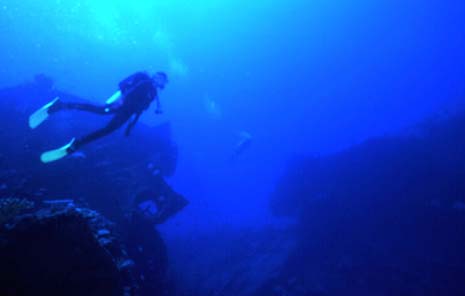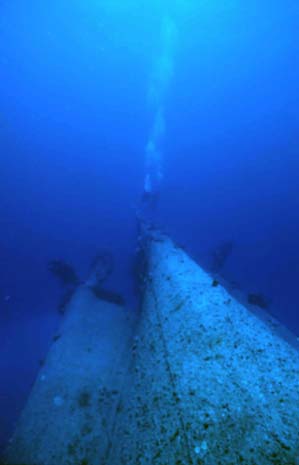|
|
|
| Missing In Action (MIA) | Prisoners Of War (POW) | Unexploded Ordnance (UXO) |
| Chronology | Locations | Aircraft | Ships | Submit Info | How You Can Help | Donate |
|
| USN Cimarron class fleet replenishment oiler 24,400 Tons 553' x 75' x 32' 2 x 5" 38 cal DP gun 4 × 3" 50 caliber guns 4 × 40mm AA guns 4 × 20mm AA cannons   USN May 1944   USN September 24, 1944   Harris November 20, 1944     Chip Lambert 2001 |
Ship History Built by Bethlehem Steel Shipyard at Sparrows Point, Maryland. Laid down October 5, 1943 as Maritime Commission type T3-S2-A3 Auxiliary Oiler under under Maritime Commission contract (MC hull 725). Launched March 28, 1944 sponsored by Mrs. Margaret Pence. Commissioned May 18, 1944 into the United States Navy (USN) as USS Mississinewa (AO-59) named for the Mississinewa River in eastern Indiana with Captain Philip G. Beck with a crew of 20 officers and 278 enlisted men. This vessel was painted in camouflage scheme measure 32, design 3AO and had a brief shakedown cruise in Chesapeake Bay. Wartime History On June 18, 1944 departed for Aruba and fueled on June 23, 1944 and June 24, 1944 then via the Panama Canal to the Pacific. On July 10, 1944 arrived at Pearl Harbor assigned to Service Squadron 10 (ServRon 10) and departed bound for Eniwetok and conducted her first fueling mission for the 3rd Fleet. On August 25, 1944 departed for Seeadler Harbor to deliver fuel and mail for Task Force 38 (TF-38). On September 24, 1944 conducted refueling operations at sea for Task Unit 32 and Task Unit 31 transferring the equivalent of almost 25,000 barrels of "Navy Special Fuel Oil" plus nearly 105,000 gallons of aviation fuel to five warships: two escort carriers including USS Sargent Bay (CVE-83) and three destroyers over a nine hour period before operations off Palau. On September 30, 1944 returned to Seeadler Harbor, refueled then proceeded northward to refuel Task Force 38 (TF-38). On October 11, 1944 refueled USS Independence (CVL-22). On October 19, 1944 arrived at Ulithi Lagoon and during early November 1944 completed another refueling operation. On November 15, 1944 arrived Ulithi Atoll (Urushi Atoll) and anchored at berth 131 in eastern Ulithi Lagoon (Urushi Lagoon) and refueled with 440,000 gallons of aviation gasoline and a full load of fuel oil. Sinking History On November 20, 1944 in the morning anchored at berth 131 in eastern Ulithi Lagoon (Urushi Lagoon) aviation fuel had been pumped from the no. 3 wing and centerline tanks and bow wing tanks no. 1 and no. 2. On orders from the captain, these tanks had not been purged by filling them with seawater. At 3:28am to 3:42am four Kaiten (manned torpedo) are launched from I-47 and at 4:15am one Kaiten launched by I-36 east of Ulithi Atoll. At 5:45am a Kaiten explodes against the USS Mississinewa. It is generally believed to have been hit by Kaiten No. 1 piloted by Lt(jg) Nishina Sekio. At 6:05am was a secondary explosion, presumably the detonation of 5" ammunition. A total of 63 crew (3 officers and 60 enlisted men) died in the attack, most in the forward compartments of the bridge and forward crew berthing area when it is consumed by flames. By 8:30am, the fires were extinguished, but her bow dipped below the surface. Rescue efforts were abandoned and the ship slowly rolled to the port causing the stern and propellers to rise above the surface before sinking at roughly Lat 10 6 N, Long 139 43 E. During World War II, Mississinewa earned four battle stars for service and was the first U. S . Navy vessel sunk by a Kaiten. Rescue After the explosion, nearby ships, an OS2U Kingfisher aircraft and fleet tug USS Munsee (ATF-107) helped rescue her crew with crew member Storekeeper 2nd Class Simon "Sid" Harris photographing the rescue and sinking. Veteran John A. Mair recalls: "I was awakened about 5:45 AM on the morning by a violent explosion forward that shook the ship from bow to stern. The explosion threw me off the cot and I landed on the well deck with a thud! My view forward was obscured by the cargo deck over my head but I knew something terrible had happened! My first thought was that a crew member had been smoking a cigarette over the forward aviation gasoline storage tanks and caused a tremendous accident. I did not realize that the explosion was a result of a Japanese attack!" Shipwreck On April 6, 2001 Chip Lambert and Pam Lambert located the shipwreck upside down at a depth of 130' after searching Ulithi Lagoon (Urushi Lagoon) for eleven days. No pieces of the Kaiten were located. In August 2001, a U.S. Navy (USN) dive team surveyed the wreck and made exploratory dives. Afterwards, Jim Delgado and Clive Cussler shot a documentary for International National Geographic Sea Hunter series. They looked extensively for the kaiten but did not find any confirmed pieces. The trip was shortened because of a typhoon. During February 2003, a U.S. Navy salvage team was tasked with recovering as much fuel as possible from the shipwreck by drilling into the oil tanks and recovered a total of 1.8 million gallons of oil. Afterwards, the recovered fuel was barged back to Singapore where it was sold for $0.50 per gallon to help cover the $11 million salvage costs. It was re-refined and in use today. References NARA "Rep of Torpedoing of the USS MISSISSINEWA in Ulithi Atoll Anchorage, Carolines, & Events in Connection Therewith, 11/20/44" Naval History and Heritage Command - Navy Department Communiques 301-600 and Pacific Fleet Communiques page 293 (N. D. COMMUNIQUÉ NO. 560, DECEMBER 19, 1944), table, index Naval History and Heritage Command - U.S. Navy at War Final Official Report Covering the period of March 1, 1945, to October 1, 1945 Naval History and Heritage Command "Beans, Bullets, and Black Oil The Story of Fleet Logistics Afloat in the Pacific During World War II" pages 249-250, 259, 260 (photo), 261, table Mississinewa AO-59 Naval History and Heritage Command - US Naval Institute Oral Histories Loughlin, Charles E., Rear Admiral U.S. Navy (Ret.) commanding officer of the oiler Mississinewa (AO-59) Naval History and Heritage Command - Mississinewa I (AO-59) NavSource - USS Mississinewa AO-59 California Dive Team Finds USS Mississinewa Bent Prop - The Search for USS Mississinewa IMDB - Human Torpedoes: The Wreck of USS Mississinewa (2003) Oil, Fire, and Fate; The Sinking of the USS Mississinewa (AO-59) in WWII by Japan's Secret Weapon (2008) by Michael Mair U.S. Navy "Salvage Report USS Mississinewa Oil Removal Operations S0300-B6-RPT-010 May 2004 [PDF] Contribute
Information Last Updated
|
Map Berth 131 130' / 39m Photo Archive |
| Discussion Forum | Daily Updates | Reviews | Museums | Interviews & Oral Histories |
|